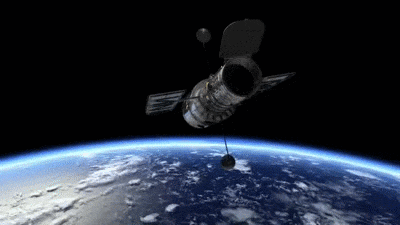NASA / ESA - Hubble Space Telescope (HST) patch.
March 1, 2023
Hubble captures DART asteroid impact debris (annotated 1)
The NASA/ESA Hubble Space Telescope captured a series of photos of rapid changes to the asteroid Dimorphos when it was deliberately hit by a 545-kilogram spacecraft on 26 September 2022. The primary objective of the NASA mission, called DART (Double Asteroid Redirection Test), was to test our ability to alter the asteroid’s trajectory as it orbits its larger companion asteroid, Didymos. Though Dimorphos poses no threat to Earth, data from the mission could help inform researchers how to potentially change an asteroid’s path away from Earth, if ever necessary.
Hubble’s resulting time-lapse movie of the aftermath of the collision reveals surprising and remarkable changes as dust and chunks of debris were flung into space from the wounded asteroid. Smashing head-on into the asteroid at 21 000 kilometres per hour, the DART impactor blasted over 900 000 kilograms of dust off of the asteroid.
Hubble captures DART asteroid impact debris (annotated 2)
The Hubble movie provides invaluable new clues into how the debris was dispersed into a complex pattern in the days following the impact.
The movie shows three overlapping stages of the aftermath of the crash: the formation of an ejecta cone, the spiral swirl of debris caught up along the asteroid’s orbit about its companion asteroid, and the tail swept behind the asteroid by the pressure of sunlight.
The Hubble movie starts at 1.3 hours before impact. In this view both Didymos and Dimorphos are within the central bright spot; even Hubble can’t resolve the two asteroids separately. The thin, straight spikes projecting away from the centre (and seen in later images) are artefacts of Hubble’s optics. The first post-impact snapshot is two hours after the event. Debris flies away from the asteroid, moving in with a range of speeds faster than four miles per hour (fast enough to escape the asteroid’s gravitational pull, so it does not fall back onto the asteroid). The ejecta forms a largely hollow cone with long, stringy filaments.
Hubble captures DART asteroid impact debris (clean)
At about 17 hours after the collision the debris pattern entered a second stage. The dynamic interaction within the binary system started to distort the cone shape of the ejecta pattern. The most prominent structures are rotating, pinwheel-shaped features. The pinwheel is tied to the gravitational pull of the companion asteroid, Didymos.
Hubble next captures the debris being swept back into a comet-like tail by the pressure of sunlight on the tiny dust particles. This stretches out into a debris train where the lightest particles travel the fastest and farthest from the asteroid. Hubble also recorded the tail splitting in two for a few days.
Due to launch in October 2024, ESA’s Hera mission will perform a detailed post-impact survey of the target asteroid Dimorphos. Hera will turn the grand-scale experiment into a well-understood and repeatable planetary defence technique that might one day be used for real.
Hubble Captures Movie of DART Asteroid Impact Debris
Just like Hubble and the NASA/ESA/CSA James Webb Space Telescope, NASA’s DART and ESA’s Hera missions are great examples of what international collaboration can achieve; the two missions are supported by the same teams of scientists and astronomers, and operate via an international collaboration called AIDA — the Asteroid Impact and Deflection Assessment.
Hubble Space Telescope (HST)
NASA and ESA worked together in the early 2000s to develop asteroid monitoring systems, but recognised there was a missing link in the chain between asteroid threat identification and ways of addressing that threat. In response NASA oversaw the DART mission while ESA developed the Hera mission to gather additional data on DART’s impact. With the Hera mission, ESA is assuming even greater responsibility for protecting our planet and ensuring that Europe plays a leading role in the common effort to tackle asteroid risks. As Europe’s flagship planetary defender, Hera is supported through the Agency’s Space Safety programme, part of the Operations Directorate.
More information
The Hubble Space Telescope is a project of international cooperation between ESA and NASA.
Links:
Hera Mission: https://www.esa.int/Space_Safety/Hera
DART Mission: https://www.nasa.gov/planetarydefense/dart/
ESA’s Vision for Space Safety: https://vision.esa.int/category/agenda-2025/space-for-safety-and-security/
Images of Hubble: https://esahubble.org/images/archive/category/spacecraft/
29 September 2022 Release: Webb and Hubble Capture Detailed Views of DART Debris: https://esahubble.org/news/heic2212/
Release on ESA website: https://www.esa.int/Science_Exploration/Space_Science/Hubble_captures_movie_of_DART_asteroid_impact_debris
Release on STScI website:
https://hubblesite.org/contents/news-releases/2023/news-2023-006
Release on NASA website:
https://www.nasa.gov/feature/goddard/2023/hubble-captures-movie-of-dart-asteroid-impact-debris
Operations Directorate: https://www.esa.int/Enabling_Support/Operations
Science paper: https://www.nature.com/articles/s41586-023-05811-4
Images, Animation Credits: NASA, ESA, STScI, J. Li (PSI)/Video Credits: NASA, ESA, J. Li (PSI), J. DePasquale (STScI)/Text Credits: ESA/Hubble/Bethany Downer/Ninja Menning.
Best regards, Orbiter.ch


.jpg)
.jpg)
.jpg)
